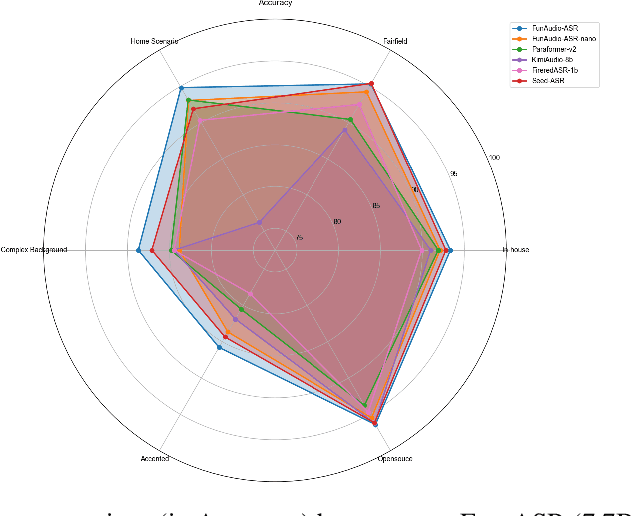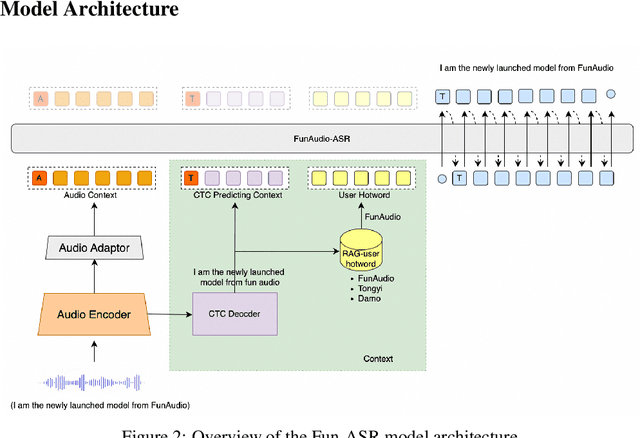speech recognition
Speech recognition is the task of identifying words spoken aloud, analyzing the voice and language, and accurately transcribing the words.
Papers and Code
Speech Language Models for Under-Represented Languages: Insights from Wolof
Sep 18, 2025We present our journey in training a speech language model for Wolof, an underrepresented language spoken in West Africa, and share key insights. We first emphasize the importance of collecting large-scale, spontaneous, high-quality speech data, and show that continued pretraining HuBERT on this dataset outperforms both the base model and African-centric models on ASR. We then integrate this speech encoder into a Wolof LLM to train the first Speech LLM for this language, extending its capabilities to tasks such as speech translation. Furthermore, we explore training the Speech LLM to perform multi-step Chain-of-Thought before transcribing or translating. Our results show that the Speech LLM not only improves speech recognition but also performs well in speech translation. The models and the code will be openly shared.
VOX-KRIKRI: Unifying Speech and Language through Continuous Fusion
Sep 19, 2025We present a multimodal fusion framework that bridges pre-trained decoder-based large language models (LLM) and acoustic encoder-decoder architectures such as Whisper, with the aim of building speech-enabled LLMs. Instead of directly using audio embeddings, we explore an intermediate audio-conditioned text space as a more effective mechanism for alignment. Our method operates fully in continuous text representation spaces, fusing Whisper's hidden decoder states with those of an LLM through cross-modal attention, and supports both offline and streaming modes. We introduce \textit{VoxKrikri}, the first Greek speech LLM, and show through analysis that our approach effectively aligns representations across modalities. These results highlight continuous space fusion as a promising path for multilingual and low-resource speech LLMs, while achieving state-of-the-art results for Automatic Speech Recognition in Greek, providing an average $\sim20\%$ relative improvement across benchmarks.
Listening, Imagining \& Refining: A Heuristic Optimized ASR Correction Framework with LLMs
Sep 18, 2025Automatic Speech Recognition (ASR) systems remain prone to errors that affect downstream applications. In this paper, we propose LIR-ASR, a heuristic optimized iterative correction framework using LLMs, inspired by human auditory perception. LIR-ASR applies a "Listening-Imagining-Refining" strategy, generating phonetic variants and refining them in context. A heuristic optimization with finite state machine (FSM) is introduced to prevent the correction process from being trapped in local optima and rule-based constraints help maintain semantic fidelity. Experiments on both English and Chinese ASR outputs show that LIR-ASR achieves average reductions in CER/WER of up to 1.5 percentage points compared to baselines, demonstrating substantial accuracy gains in transcription.
Chunk Based Speech Pre-training with High Resolution Finite Scalar Quantization
Sep 19, 2025Low latency speech human-machine communication is becoming increasingly necessary as speech technology advances quickly in the last decade. One of the primary factors behind the advancement of speech technology is self-supervised learning. Most self-supervised learning algorithms are designed with full utterance assumption and compromises have to made if partial utterances are presented, which are common in the streaming applications. In this work, we propose a chunk based self-supervised learning (Chunk SSL) algorithm as an unified solution for both streaming and offline speech pre-training. Chunk SSL is optimized with the masked prediction loss and an acoustic encoder is encouraged to restore indices of those masked speech frames with help from unmasked frames in the same chunk and preceding chunks. A copy and append data augmentation approach is proposed to conduct efficient chunk based pre-training. Chunk SSL utilizes a finite scalar quantization (FSQ) module to discretize input speech features and our study shows a high resolution FSQ codebook, i.e., a codebook with vocabulary size up to a few millions, is beneficial to transfer knowledge from the pre-training task to the downstream tasks. A group masked prediction loss is employed during pre-training to alleviate the high memory and computation cost introduced by the large codebook. The proposed approach is examined in two speech to text tasks, i.e., speech recognition and speech translation. Experimental results on the \textsc{Librispeech} and \textsc{Must-C} datasets show that the proposed method could achieve very competitive results for speech to text tasks at both streaming and offline modes.
Frustratingly Easy Data Augmentation for Low-Resource ASR
Sep 18, 2025This paper introduces three self-contained data augmentation methods for low-resource Automatic Speech Recognition (ASR). Our techniques first generate novel text--using gloss-based replacement, random replacement, or an LLM-based approach--and then apply Text-to-Speech (TTS) to produce synthetic audio. We apply these methods, which leverage only the original annotated data, to four languages with extremely limited resources (Vatlongos, Nashta, Shinekhen Buryat, and Kakabe). Fine-tuning a pretrained Wav2Vec2-XLSR-53 model on a combination of the original audio and generated synthetic data yields significant performance gains, including a 14.3% absolute WER reduction for Nashta. The methods prove effective across all four low-resource languages and also show utility for high-resource languages like English, demonstrating their broad applicability.
Impact of Phonetics on Speaker Identity in Adversarial Voice Attack
Sep 18, 2025Adversarial perturbations in speech pose a serious threat to automatic speech recognition (ASR) and speaker verification by introducing subtle waveform modifications that remain imperceptible to humans but can significantly alter system outputs. While targeted attacks on end-to-end ASR models have been widely studied, the phonetic basis of these perturbations and their effect on speaker identity remain underexplored. In this work, we analyze adversarial audio at the phonetic level and show that perturbations exploit systematic confusions such as vowel centralization and consonant substitutions. These distortions not only mislead transcription but also degrade phonetic cues critical for speaker verification, leading to identity drift. Using DeepSpeech as our ASR target, we generate targeted adversarial examples and evaluate their impact on speaker embeddings across genuine and impostor samples. Results across 16 phonetically diverse target phrases demonstrate that adversarial audio induces both transcription errors and identity drift, highlighting the need for phonetic-aware defenses to ensure the robustness of ASR and speaker recognition systems.
FunAudio-ASR Technical Report
Sep 15, 2025



In recent years, automatic speech recognition (ASR) has witnessed transformative advancements driven by three complementary paradigms: data scaling, model size scaling, and deep integration with large language models (LLMs). However, LLMs are prone to hallucination, which can significantly degrade user experience in real-world ASR applications. In this paper, we present FunAudio-ASR, a large-scale, LLM-based ASR system that synergistically combines massive data, large model capacity, LLM integration, and reinforcement learning to achieve state-of-the-art performance across diverse and complex speech recognition scenarios. Moreover, FunAudio-ASR is specifically optimized for practical deployment, with enhancements in streaming capability, noise robustness, code-switching, hotword customization, and satisfying other real-world application requirements. Experimental results show that while most LLM-based ASR systems achieve strong performance on open-source benchmarks, they often underperform on real industry evaluation sets. Thanks to production-oriented optimizations, FunAudio-ASR achieves SOTA performance on real application datasets, demonstrating its effectiveness and robustness in practical settings.
From Who Said What to Who They Are: Modular Training-free Identity-Aware LLM Refinement of Speaker Diarization
Sep 18, 2025Speaker diarization (SD) struggles in real-world scenarios due to dynamic environments and unknown speaker counts. SD is rarely used alone and is often paired with automatic speech recognition (ASR), but non-modular methods that jointly train on domain-specific data have limited flexibility. Moreover, many applications require true speaker identities rather than SD's pseudo labels. We propose a training-free modular pipeline combining off-the-shelf SD, ASR, and a large language model (LLM) to determine who spoke, what was said, and who they are. Using structured LLM prompting on reconciled SD and ASR outputs, our method leverages semantic continuity in conversational context to refine low-confidence speaker labels and assigns role identities while correcting split speakers. On a real-world patient-clinician dataset, our approach achieves a 29.7% relative error reduction over baseline reconciled SD and ASR. It enhances diarization performance without additional training and delivers a complete pipeline for SD, ASR, and speaker identity detection in practical applications.
Language Conditioning Improves Accuracy of Aircraft Goal Prediction in Untowered Airspace
Sep 17, 2025Autonomous aircraft must safely operate in untowered airspace, where coordination relies on voice-based communication among human pilots. Safe operation requires an aircraft to predict the intent, and corresponding goal location, of other aircraft. This paper introduces a multimodal framework for aircraft goal prediction that integrates natural language understanding with spatial reasoning to improve autonomous decision-making in such environments. We leverage automatic speech recognition and large language models to transcribe and interpret pilot radio calls, identify aircraft, and extract discrete intent labels. These intent labels are fused with observed trajectories to condition a temporal convolutional network and Gaussian mixture model for probabilistic goal prediction. Our method significantly reduces goal prediction error compared to baselines that rely solely on motion history, demonstrating that language-conditioned prediction increases prediction accuracy. Experiments on a real-world dataset from an untowered airport validate the approach and highlight its potential to enable socially aware, language-conditioned robotic motion planning.
Canary-1B-v2 & Parakeet-TDT-0.6B-v3: Efficient and High-Performance Models for Multilingual ASR and AST
Sep 17, 2025This report introduces Canary-1B-v2, a fast, robust multilingual model for Automatic Speech Recognition (ASR) and Speech-to-Text Translation (AST). Built with a FastConformer encoder and Transformer decoder, it supports 25 languages primarily European. The model was trained on 1.7M hours of total data samples, including Granary and NeMo ASR Set 3.0, with non-speech audio added to reduce hallucinations for ASR and AST. We describe its two-stage pre-training and fine-tuning process with dynamic data balancing, as well as experiments with an nGPT encoder. Results show nGPT scales well with massive data, while FastConformer excels after fine-tuning. For timestamps, Canary-1B-v2 uses the NeMo Forced Aligner (NFA) with an auxiliary CTC model, providing reliable segment-level timestamps for ASR and AST. Evaluations show Canary-1B-v2 outperforms Whisper-large-v3 on English ASR while being 10x faster, and delivers competitive multilingual ASR and AST performance against larger models like Seamless-M4T-v2-large and LLM-based systems. We also release Parakeet-TDT-0.6B-v3, a successor to v2, offering multilingual ASR across the same 25 languages with just 600M parameters.
 Add to Chrome
Add to Chrome Add to Firefox
Add to Firefox Add to Edge
Add to Edge